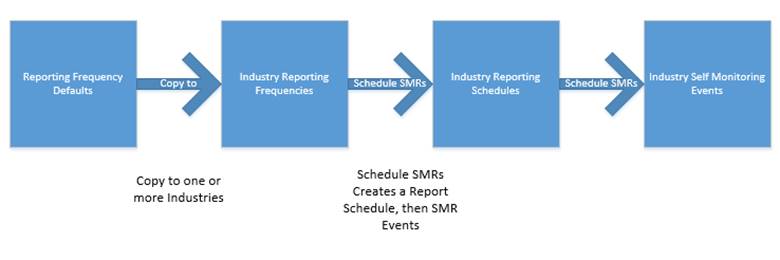The SMR reporting frequencies (or requirements) have been defined and defaults copied to an industry or group of industries. These assigned requirements may now be reviewed or edited. The requirements will not take effect until the user presses “Schedule SMRs for Listed Frequencies” button. This can be done for single industry or a group of industries. Once schedules have been created for the reporting frequencies (requirements), the Scheduled SMRs process does not have to be done again unless there is a change or update to the defined reporting frequencies.
These assigned
requirements may now be reviewed or edited and you can make manual changes if
needed. Go to Schedule Industry Reporting Frequencies.

1.
This
shows the Industry Reporting Frequencies
that are defined for an Industry.
2.
The
data is identical to what was copied in except we now see Frequency End Date.
This is like a retire date. No SMRs are
scheduled after this date. This is used
if you want to stop scheduling this SMR for this Industry.
3.
Details
button allows you to edit the Reporting Frequencies if needed. Editing a
Reporting Frequency does not affect currently scheduled SMRs – they will not be
deleted or changed unless Schedule SMRs
for Listed Frequencies is pressed.
4.
The
Schedule Exists data-column will quickly allow you to see if any
reporting schedule exists for this Industry Reporting Frequency. Use this field and filter to quickly limit
the list to those Industries that need to have SMRs scheduled.
5.
Schedule SMRs for
Listed Frequencies will create the
Reporting Schedule and then the SMR Events for those records that are filtered
on the screen.
6.
View Missing SMRs will display information for 1) No Reporting Frequencies
(reporting requirements) have been assigned to an Industry 2) No Reporting
Scheduled Exists for 1 or more of the Reporting Frequencies (ie. the Schedule
SMRS for Listed Frequencies has not been pressed) and 3) A Reporting Schedule
exists, but the related SMR Event does not, implying the SMR Event was deleted
or the dates changed in the SMR List View.
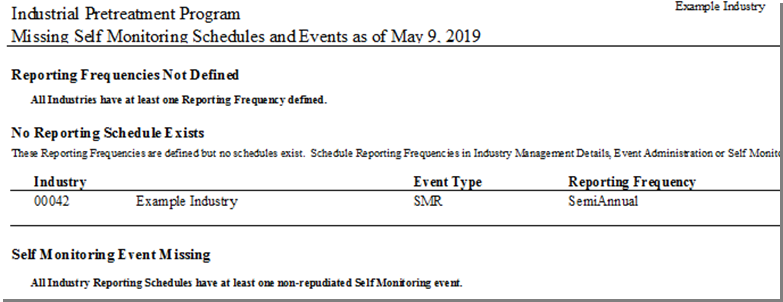
Best Practice:
If you change a Reporting Frequency, you should reschedule the SMRs. Just like in Mon Points when you change you should “Create Schedule” again when IU or Auth sampling frequencies change. Failure to do so will result in forecasted schedules thru the configured date range (e.g. 15 months into the future) that do not match the updated schedule for the IU’s required reports.
Industry Reporting Frequencies screen may be reached from Schedule Industry Reporting Frequencies button in the Event Admin screen or from the Industry Reporting Frequencies button in the Self Monitoring events screen off of the main menu. Users may add new frequency definitions here or click the Details button of this screen to manage existing frequencies.
Click Details to manage a specific Industry’s Reporting Frequency, or Schedule SMRs for that one frequency for that one Industry.
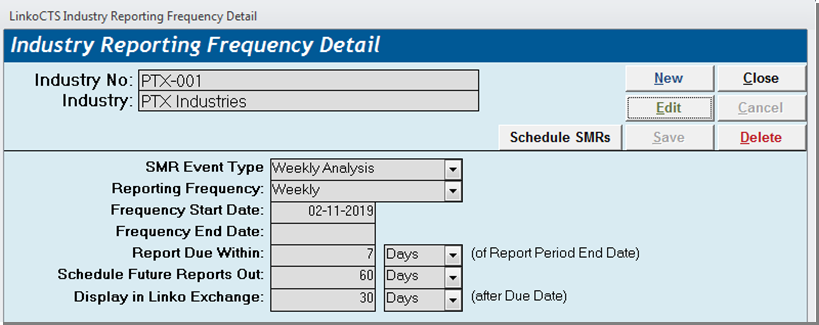
Click Edit, you will be warned about editing an existing schedule, but you can bypass and edit similar to MonPoint Limits.
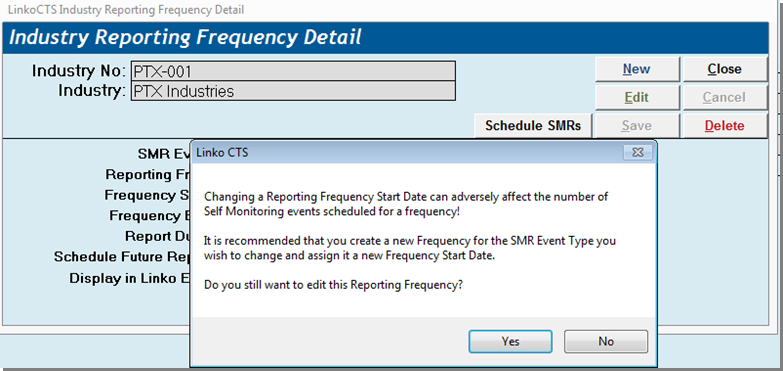
All fields are required except Frequency End Date, and the bottom item ( Display in LinkoExchange: ) will only be displayed if LinkoExchange is enabled.
Executing the Delete button will produce a message prompts user of all deletions involved. When user answers Yes, the process will delete all Report Schedule records for this frequency, and all incomplete Self Monitoring events related to this frequency.
There is a new SMR Reporting Frequencies TAB at the Industry Detail level. If you prefer scheduling/working at the Industry Detail level, you may do so via this new TAB:
· Add New or Details – opens the Industry Reporting Frequency Detail screen discussed previously.
· Copy Frequency Defaults – opens the Copy Reporting Frequency Defaults screen; the current Industry is automatically selected and that field is locked.
· Schedule Industry SMRs – creates the reporting schedules and creates Self Monitoring events for all frequencies for the current Industry.
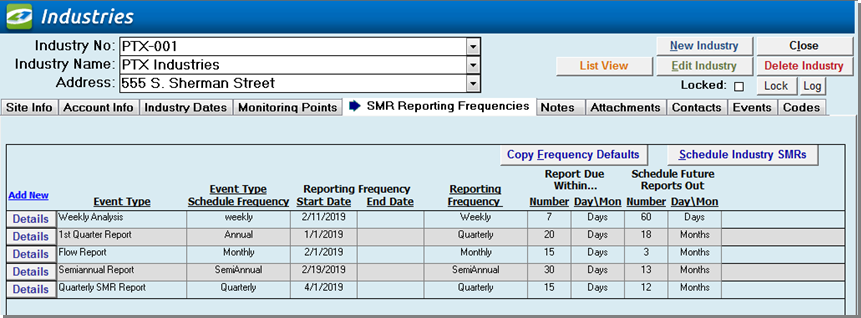
On the Configurations tab in System Administration > Event Administration there is an option to “Lock auto-created Self Monitoring Events”. When this is checked, on creation of an SMR Event, that event will be created ‘Locked’ by default, which will prevent users from editing or deleting unless they have the appropriate workgroup permissions to execute the Unlock/Log feature.

As the popup message in the above image states, only unlocked SMR events that are incomplete can be deleted and recreated.
Locked SMR Events cannot be deleted, which means when you press Create SMR buttons, no previously created SMRs will be deleted and recreated. To address this, a configuration exists in Event Administration à Configurations tab.
![]()
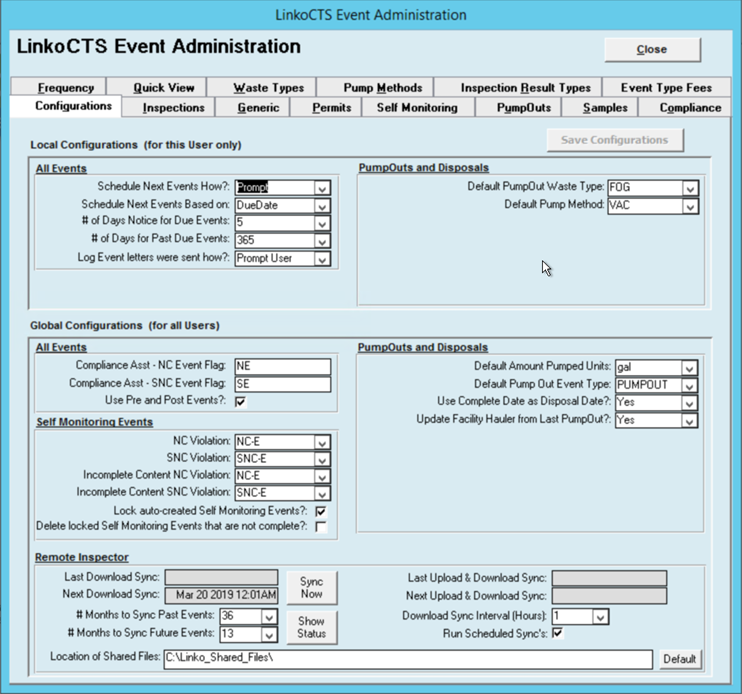
By checking “Delete locked Self Monitoring Events that are not complete”, locked SMR Events will be deleted and recreated. Completed SMR Events are never automatically deleted.
Just like COCs, if a schedule exists for an Industry Reporting Frequency, the software will look at the last Report Schedule (not the SMR Event) and will schedule the next one from that by adding “Reporting Frequency” to it.

In this
example, the first SMR Event scheduled was:
Event Type: Seminannual SMR
Period Start Date: Jan 1 2019
Period End Date: Jun 30 2019
On July 1, 2019 the software will automatically create the next Seminannual SMR.
It does this because the next Report Period End Date for this semiannual SMR is Dec 31st and we have configured the software to Schedule Future Reports out 6 Months.
